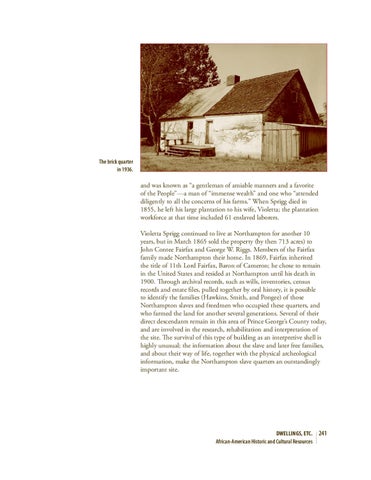The brick quarter in 1936.
and was known as “a gentleman of amiable manners and a favorite of the People”—a man of “immense wealth” and one who “attended diligently to all the concerns of his farms.” When Sprigg died in 1855, he left his large plantation to his wife, Violetta; the plantation workforce at that time included 61 enslaved laborers. Violetta Sprigg continued to live at Northampton for another 10 years, but in March 1865 sold the property (by then 713 acres) to John Contee Fairfax and George W. Riggs. Members of the Fairfax family made Northampton their home. In 1869, Fairfax inherited the title of 11th Lord Fairfax, Baron of Cameron; he chose to remain in the United States and resided at Northampton until his death in 1900. Through archival records, such as wills, inventories, census records and estate files, pulled together by oral history, it is possible to identify the families (Hawkins, Smith, and Pongee) of those Northampton slaves and freedmen who occupied these quarters, and who farmed the land for another several generations. Several of their direct descendants remain in this area of Prince George’s County today, and are involved in the research, rehabilitation and interpretation of the site. The survival of this type of building as an interpretive shell is highly unusual; the information about the slave and later free families, and about their way of life, together with the physical archeological information, make the Northampton slave quarters an outstandingly important site.
DWELLINGS, ETC. African-American Historic and Cultural Resources
241
